The Ultimate Chinese Wok Buying Guide:
Are you ready to take your stir-frying skills to the next level? Look no further than the versatile and iconic Chinese wok. If you love Asian cuisine, a good-quality wok is a must-have addition to your kitchen gear collection. Moreover, the right wok determines your recipes’ final taste and texture, your cooking experience, and the lifespan it will serve you. But with so many options available, how do you choose the right one?
This comprehensive buying guide will walk you through everything you need to know to make an informed decision.
Read More: Best Woks in Australia 2023 — Everything You Need To Know
Table of Contents
Round-bottom vs. Flat-bottom Wok
The first thing you have to determine when choosing a Chinese wok for your kitchen is whether you buy the round-bottom wok, or the flat-bottom wok.
The classic round-bottom wok has a deep, rounded bottom and high, sloping sides, and it is designed for special wok stoves with a round opening in the middle—this kind of stove you may see in Chinese restaurants. The standard gas stoves also go well with round-bottom woks. The classic round-bottom wok evenly distributes heat across the surface and ensures that food cooks uniformly. This type of wok is best for stir-frying and other high-heat cooking that requires constant tossing and stirring of the ingredients. The round-bottom wok is also the best choice for achieving the smoky, seared flavor that is the hallmark of great stir-fries.
However, if your kitchen is equipped with a flat electric or inductive stove, in order to use the classic round-bottom wok, you will need to buy a unique wok ring; otherwise, the bottom contact with the heat source is not enough for heating the wok quickly and uniformly. Alternatively, you can opt for a flat-bottom wok, this type of wok provides better contact between the wok bottom and the heat source, and you can use it on all types of cooking surfaces; they are more universal and adapted for modern kitchens.
Types of Chinese Woks Materials
Chinese woks are crafted from various materials, such as carbon steel, cast iron, stainless steel, electric, non-stick surfaces such as Teflon, and hammered covering, each bringing its own set of advantages and may have some disadvantages. Your choice should be driven by the recipes you plan to cook and, to some extent, by your experience with wok cooking.
Carbon Steel Woks: The Agile Stir-Fry Maestro
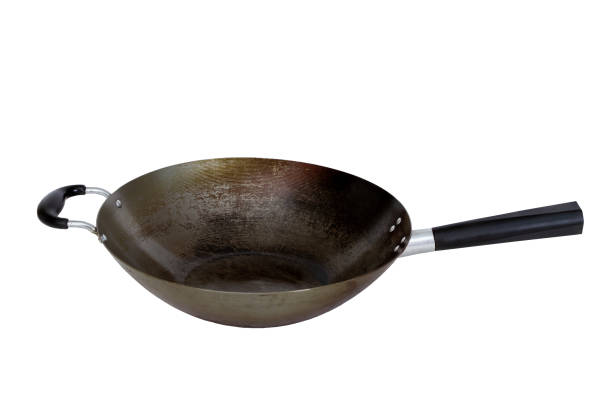
The carbon steel woks are lightweight and excel at rapid and uniform heating; no wonder they are most popular among Asian chefs. They are also more affordable and much lighter than cast-iron wok.
However, the main feature of the carbon steel woks that makes them so popular is that they heat up super-fast and spread heat nicely and evenly, which is essential to cooking any Asian recipe. Plus, they develop this fantastic non-stick surface. However, you have to take care of it and apply proper seasoning on a regular basis. When it develops a non-stick patina, it brings many benefits, such as reducing the need for excessive oil usage, which can be particularly appealing for health-conscious cooks. Carbon steel woks are ideal for stir-frying, deep-frying, and steaming dishes.
However, it is important to note that carbon steel woks require regular maintenance to prevent rust.
Cast Iron Woks: The Slow Cooker’s Best Friend

Cast iron woks have a long history and have been a staple in Chinese households for many years. These woks are thick, heavyweight, and very durable, and they come with their own set of quirks. They require a longer heat-up time compared to carbon steel but are best at heat retention and maintaining high temperatures evenly distributed across wok. Thus, the slow and steady heating makes them ideal for searing, slow cooking, and deep-frying dishes that demand prolonged cooking and a rich, deep flavor profile.
They can also cool down quickly when adding a bunch of liquid or a load of veggies, and this makes them the top choice for speedy stir-fries, which are all about fast cooking.
However, the good news is that lighter-cast iron woks are available these days. They are a bit easier to handle, and the price tag won’t break the bank—usually less than ten bucks without a cover. However, cast iron cookware requires a lot of care from the user; otherwise, it will rust quickly.
Stainless Steel Woks: The Versatile Kitchen Tool
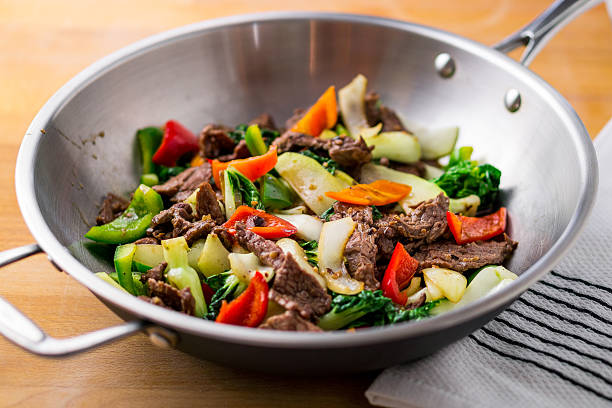
Stainless steel works are the most versatile wok because they are very durable, resistant to staining, non-reactive to acids, and easy to clean.
However, it is important to note that stainless steel woks may not heat as evenly as carbon steel or cast iron woks, so close temperature watching is very important if you use them for stir-frying or other high-heat recipes.
Stainless steel woks are the best option for making dishes with vinegar or acidic ingredients, like Chinese sweet and sour Fish stir-fry, sweet and Sour spareribs, Tso’s chicken, etc., because they are non-reactive to food. They are also excellent for steaming, usually with a handy glass cover, since they won’t rust from all that steaming moisture. Stainless steel works are also well suited for recipes that require browning and deglazing, as they are resistant to stains and easy to clean.
Taking care of a stainless steel wok is a breeze; you just wash it, wipe it to dry, and you are all set. It does not require all the fuss about seasoning you would do for cast iron or carbon steel. And if your stainless steel wok has a metal handle, you can even use it for oven cooking and heating. So, stainless steel is the way to go if you’re looking for an easy-going wok buddy.
Non-stick Woks: The Easy-Going Everyday Companion
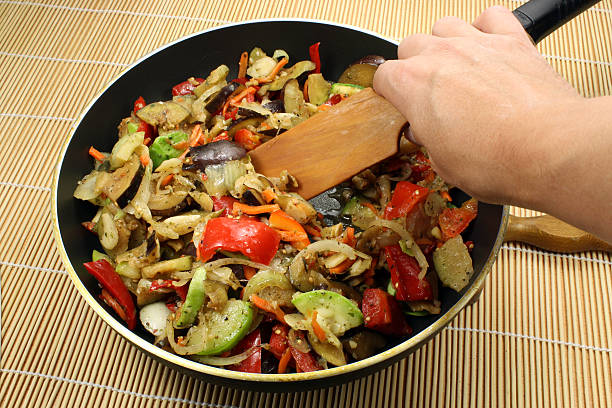
Non-stick woks are the easiest to use and the best option for Asian cooking beginners. They require minimal seasoning, use minimum cooking oil, and are very easy to clean since food doesn’t cling to the wok’s non-stick-coated surface.
However, it is important to be aware that the non-stick woks have a short lifespan as their coating wears off over time. They are also unsuited for high-heat recipes since Teflon coatings become toxic when exposed to very high temperatures.
The newer non-stick option is the ceramic wok, which is a bit more durable than their Teflon-coated ones. But, just like Teflon, they can get scratched up and lose their non-stick magic over time. While they are the best beginner’s cooker option, you will have to be gentle with them.
Electric Woks: The Modern and Adaptable Innovator
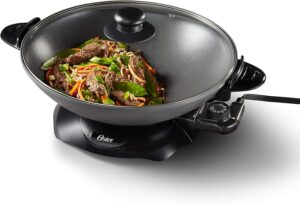
Electric woks are the modern wok option; they have an electric heating element and control panel that ensures precise temperature control. Thus, they are very easy to use and have a very good heat distribution, which makes them suitable for stir-frying, braising, and other Asian recipes.
Although they do not reach the same high heat levels as standard woks, they are an excellent choice for those with limited stovetop space or those who prefer countertop cooking.
Hammered Woks: The Artistic Allure of Texture
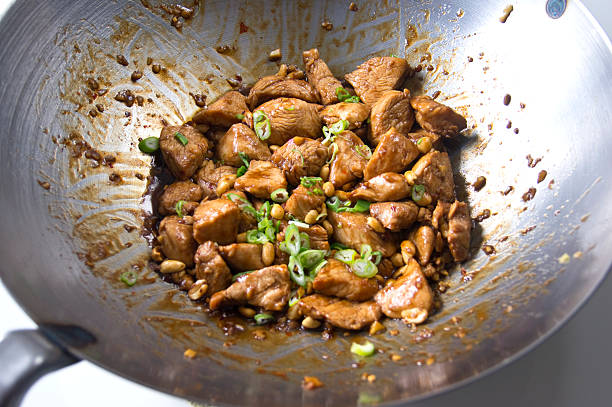
Hammered woks are pretty unique; they are often handcrafted, not just as cookware but as pieces of art in your kitchen. They are non-stick woks because they are constructed with specially textured surfaces with tiny air pockets. They also spread the heat evenly, so they are suitable for most Asian dishes, and the textured surface provides the perfect sear on most of the ingredients.
So, if you are looking to take your cooking up a notch and want a piece of kitchen art, consider a hammered wok.
However, it is important to note that these woks require more effort to maintain than those with smooth surfaces.
Choosing the Right Size
Typical woks available to buy today are typically sized from 12 to 16 inches in diameter, and your choice should depend on the dishes you plan to cook and the number of people you plan to cook for.
- For small households consisting of 1–4 people, a 12 to 14-inch wok is often ideal. It is large enough for stir-frying and sautéing and will not be very heavy, so you can easily handle it.
- Families or those who often cook for 5 or more people will require a 14 to 16-inch-diameter wok, so it will be able to accommodate more ingredients for generous portions, making it perfect for dishes that are meant to be shared.
- In contrast, professional kitchens or large-scale cooking may require even larger woks, sometimes exceeding 20 inches in diameter. These giants are designed for high-capacity cooking and are typically used by experienced chefs who cook in bulk.
Your wok also comfortably fits on your stove or cooking surface; if it is too large for your stove, it will lead to uneven heating and difficulties in food preparation. So, this factor should also be considered when you choose your ideal wok.
Wok Handle for Enhanced Control
Nowadays, you are most likely to come across woks with three primary wok handle designs, such as 1) woks with two loop handles on the opposite side, 2) a long handle on one side, and 3) woks with a long handle on one side and a loop handle on the opposite side. All the designs have their own history and practical application.
Loop handles: Traditionally, all woks had two small metal handles at opposite ends since they were large, heavy, and typically sat stationary over a flame. Nowadays, they are most common for Cantonese or southern-style woks with round bottoms. They are also used for heavy cast-iron woks and large-diameter woks because woks with two metal handles are easier to lift and transport. Cooks usually hold a loop handle with a thick towel and toss and flip the food while cooking.
Long wooden handle woks feature Mandarin-style or Northern Chinese-style woks, often called ” Pow” flat-bottom woks. They are comfortable to hold, and the cook can stay at a safe distance from the heat source. The extended handle provides better leverage when lifting, tilting, or shaking the wok. This handle style is suitable for various cooking techniques, from stir-frying to simmering. Nowadays, single-handle woks are usually used in stir-fry stations and Asian restaurants.
Side Handles: Some woks come with long wooden handles and side handles in addition to the main one. These side handles enhance stability and make lifting and transferring the wok easier. They are especially handy when the wok is heavy or you need to move it from the stovetop to the oven.

